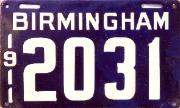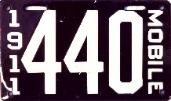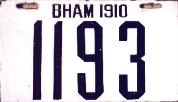PORCELAIN PLATES.NET A Website for Porcelain License Plate Collectors & Enthusiasts |
Alabama Archive
TOTAL KNOWN PORCELAIN VARIETIES: 17
I: PRE-STATES / CITY & COUNTY PLATES
The state of Alabama did not begin issuing license plates until 1912. However,
prior to that date, numerous cities experimented with the issuance of license
plates. In some cases, these were simply dashboard disks, while in other cases
the plates were embossed metal plates, such as a dated 1911 plate from
Birmingham marked “one horse dray.” But in Birmingham, as well as the cities of
Mobile, Montgomery and Dothan, local officials also decided to experiment with
porcelain issues. All three cities appear to have begun in 1909, and by the time
the first state issued plates were introduced 3 years later, no further city
porcelains were manufactured. This brief heyday of city porcelains from the state
of Alabama is marked by 9 known surviving varieties.
BIRMINGHAM
Plates from Birmingham were relatively normal, with no odd shapes or colors, and
were issued annually from 1909 through 1911. We do know that a formal 1908
plate was also issued in Birmingham based on old photographs, but it is not
known whether or not this plate was porcelain, and no surviving examples exist.
None of the porcelain 1909-1911 plates was issued in pairs. The 1909 issue was
manufactured by the Baltimore Sign and Enamel Company, and bears a maker’s
mark on the back from this manufacturer. The later two years bear no maker’s
mark. One interesting mystery surrounding Birmingham plates comes with the
1910 issue, for which two very distinct varieties of plates are known. Of the
dozen or so plates from 1910, the two highest known surviving examples were
manufactured in an entirely different pattern, perhaps reflecting a late order for
plates that had to be filled by a new vendor.
DOTHAN
Dothan is a small city in the Southwestern corner of the state of Alabama. Little is
known about the history of license plates from this jurisdiction. However, there
are three known 1911 porcelains that have survived. The layout of these pl ates
is somewhat reminiscent of the Lexington, Kentucky 1911 porcelains, but it is not
clear if they were manufactured by the same company.
MOBILE
Like Birmingham, the city of Mobile also had three annual issues dating between
1909 and 1911, including an introductory issue with a very distinct color
combination of black letter and numbers on an olive green background. This 1909
plate also has a mysterious mark on the back – a red “2 9” over a red “10.” The
top numbers appear to suggest that the plates were manufactured in February of
1909, but the “10” on the bottom remains unexplained. Like the Birmingham 1909
issue, the Mobile 1911 plates are stamped on the reverse with the Baltimore
Enamel and Novelty Company mark.
MONTGOMERY
Unlike Birmingham and Mobile, the city of Montgomery appears to have stopped
the issuance of porcelain license plates after just one issue. Like its sister cities,
a 1909 plate was manufactured, but collectors are baffled as to why no 1910 or
1911 plates have ever shown up. Some collectors have theorized that the
purchasing agent ordered too many plates in 1909, and that the city simply
continued to use the surplus over the next two years. Furthermore, with the
exception of the odd type 2 Birmingham 1910, the Montgomery 1909 plate is the
rarest of all the Alabama city porcelains. It too was manufactured by the Baltimore
Sign and Enamel Company. It appears that perhaps all of the surviving examples
are from a Montgomery landfill on the Alabama River where these plates were dug
up many years ago.
II: STATE-ISSUED PASSENGER PLATES
The era of city plates came to an end with the passage of the Motor Vehicle Law,
effective October 1, 1911. With this law, the state took over and contracted with
the Baltimore Enamel and Novelty Company to produce a series of four annual
undated porcelain issues beginning in 1912. Each of these plates was issued in
pairs. Like most southern porcelains, these plates are tough to find in nice
condition, especially the 1912 plate, which is one of the tougher state issued
porcelains to find from the entire country. This run of four porcelain plates
comprises the longest run of state issued porcelains from any southern state.
These plates maintain a consistent size, and do not vary depending on the plate
number. Beginning in 1916, the state switched to embossed metal plates, ending
the issuance of porcelain plates from the state.
III: STATE-ISSUED NON-PASSENGER PLATES
DEALER
Although dealer plates are presumed to have been issued from the very start, no
1912 or 1915 issues are known in collectors’ hands. Interestingly, however, there
is a 1913 plate known which was clearly fired over an unused 1912 dealer. The
dealer plates are in exactly the same format as the passenger plates, with the
exception of a “D” suffix to denote their specific use. Alabama porcelain dealer
plates are all but unknown, with only two known 1913s. 1914 is virtually the only
year in which plates are ever seen - and then only because a group of what were
probably un-issued plates was dug up years ago. 1913 dealers appear to begin
around plate #4800, while the known 1914 dealers are all between #6068 and
#6099.
MOTORCYCLE
As for motorcycle plates, very few of these are known from any year. Again, cycle
plates were likely issued as early as 1912, but the first known example dates from
1914. Both the 1914 and 1915 issues are distinctive for their shape – laid out on a
tall but skinny porcelain base. Furthermore, these plates were gently curved
from top to bottom so that the plates could fit snugly against a motorcycle’s
fender. Alabama and Virginia are the only southern states to have issued curved
porcelain motorcycle plates.
FURTHER READING
Roy A. Carson, “Alabama – Heart of Dixie.” ALPCA Newsletter, 37, 5 (October 1991),
pp. 138-53.
Len Harris, “Alabama: The Montgomery Mystery and Other Pre-State Tales.”
ALPCA Register, 50, 4 (August, 2004), pp. 10-12.
I: PRE-STATES / CITY & COUNTY PLATES
The state of Alabama did not begin issuing license plates until 1912. However,
prior to that date, numerous cities experimented with the issuance of license
plates. In some cases, these were simply dashboard disks, while in other cases
the plates were embossed metal plates, such as a dated 1911 plate from
Birmingham marked “one horse dray.” But in Birmingham, as well as the cities of
Mobile, Montgomery and Dothan, local officials also decided to experiment with
porcelain issues. All three cities appear to have begun in 1909, and by the time
the first state issued plates were introduced 3 years later, no further city
porcelains were manufactured. This brief heyday of city porcelains from the state
of Alabama is marked by 9 known surviving varieties.
BIRMINGHAM
Plates from Birmingham were relatively normal, with no odd shapes or colors, and
were issued annually from 1909 through 1911. We do know that a formal 1908
plate was also issued in Birmingham based on old photographs, but it is not
known whether or not this plate was porcelain, and no surviving examples exist.
None of the porcelain 1909-1911 plates was issued in pairs. The 1909 issue was
manufactured by the Baltimore Sign and Enamel Company, and bears a maker’s
mark on the back from this manufacturer. The later two years bear no maker’s
mark. One interesting mystery surrounding Birmingham plates comes with the
1910 issue, for which two very distinct varieties of plates are known. Of the
dozen or so plates from 1910, the two highest known surviving examples were
manufactured in an entirely different pattern, perhaps reflecting a late order for
plates that had to be filled by a new vendor.
DOTHAN
Dothan is a small city in the Southwestern corner of the state of Alabama. Little is
known about the history of license plates from this jurisdiction. However, there
are three known 1911 porcelains that have survived. The layout of these pl ates
is somewhat reminiscent of the Lexington, Kentucky 1911 porcelains, but it is not
clear if they were manufactured by the same company.
MOBILE
Like Birmingham, the city of Mobile also had three annual issues dating between
1909 and 1911, including an introductory issue with a very distinct color
combination of black letter and numbers on an olive green background. This 1909
plate also has a mysterious mark on the back – a red “2 9” over a red “10.” The
top numbers appear to suggest that the plates were manufactured in February of
1909, but the “10” on the bottom remains unexplained. Like the Birmingham 1909
issue, the Mobile 1911 plates are stamped on the reverse with the Baltimore
Enamel and Novelty Company mark.
MONTGOMERY
Unlike Birmingham and Mobile, the city of Montgomery appears to have stopped
the issuance of porcelain license plates after just one issue. Like its sister cities,
a 1909 plate was manufactured, but collectors are baffled as to why no 1910 or
1911 plates have ever shown up. Some collectors have theorized that the
purchasing agent ordered too many plates in 1909, and that the city simply
continued to use the surplus over the next two years. Furthermore, with the
exception of the odd type 2 Birmingham 1910, the Montgomery 1909 plate is the
rarest of all the Alabama city porcelains. It too was manufactured by the Baltimore
Sign and Enamel Company. It appears that perhaps all of the surviving examples
are from a Montgomery landfill on the Alabama River where these plates were dug
up many years ago.
II: STATE-ISSUED PASSENGER PLATES
The era of city plates came to an end with the passage of the Motor Vehicle Law,
effective October 1, 1911. With this law, the state took over and contracted with
the Baltimore Enamel and Novelty Company to produce a series of four annual
undated porcelain issues beginning in 1912. Each of these plates was issued in
pairs. Like most southern porcelains, these plates are tough to find in nice
condition, especially the 1912 plate, which is one of the tougher state issued
porcelains to find from the entire country. This run of four porcelain plates
comprises the longest run of state issued porcelains from any southern state.
These plates maintain a consistent size, and do not vary depending on the plate
number. Beginning in 1916, the state switched to embossed metal plates, ending
the issuance of porcelain plates from the state.
III: STATE-ISSUED NON-PASSENGER PLATES
DEALER
Although dealer plates are presumed to have been issued from the very start, no
1912 or 1915 issues are known in collectors’ hands. Interestingly, however, there
is a 1913 plate known which was clearly fired over an unused 1912 dealer. The
dealer plates are in exactly the same format as the passenger plates, with the
exception of a “D” suffix to denote their specific use. Alabama porcelain dealer
plates are all but unknown, with only two known 1913s. 1914 is virtually the only
year in which plates are ever seen - and then only because a group of what were
probably un-issued plates was dug up years ago. 1913 dealers appear to begin
around plate #4800, while the known 1914 dealers are all between #6068 and
#6099.
MOTORCYCLE
As for motorcycle plates, very few of these are known from any year. Again, cycle
plates were likely issued as early as 1912, but the first known example dates from
1914. Both the 1914 and 1915 issues are distinctive for their shape – laid out on a
tall but skinny porcelain base. Furthermore, these plates were gently curved
from top to bottom so that the plates could fit snugly against a motorcycle’s
fender. Alabama and Virginia are the only southern states to have issued curved
porcelain motorcycle plates.
FURTHER READING
Roy A. Carson, “Alabama – Heart of Dixie.” ALPCA Newsletter, 37, 5 (October 1991),
pp. 138-53.
Len Harris, “Alabama: The Montgomery Mystery and Other Pre-State Tales.”
ALPCA Register, 50, 4 (August, 2004), pp. 10-12.
|
|
|
|
|
|
|
















